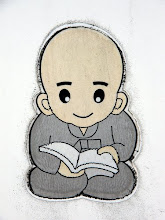 http://www.khandro.net/deities_Tara1.htm
http://www.khandro.net/deities_Tara1.htmGreen Tara Mantra - Oṃ Tāre Tuttāre Ture Svāhā / Om Tare Tuttare Ture Svaha
In Tibetan culture, and some others, green is considered to include all the other colors.
Green Tara is typically pictured as a dark, green-skinned girl of 16. She usually wears striped leggings but above, only her shoulders are covered. She wears the many characteristic ornaments of the samboghakaya.
Green Tara has her right foot extended as if about to rise. Her left hand, in the gesture of granting refuge holds the stem of a blue water lily or utpala that waves over her left shoulder while her right hand also holding a flower, offers that which we desire, a boon.
According to the first Dalai Lama (1391-1474,) her hands with their blue utpalas signal, "Samsaric beings! Cling not to worldly pleasures. Enter the great city of liberation! Flower-goads prodding us to effort. Homage to you!"
The practice of Green Tara helps to overcome fear and anxiety, but devotees also believe that she can grant wishes, eliminate suffering of all kinds and bring happiness.
When called upon, she instantaneously saves us from eight specific calamities. (Another lineage describes 16.) The First Dalai Lama lists the 8, and interprets them as representative of corresponding defects, flaws, or obscurations:
1) lions and pride
2) wild elephants and delusions
3) forest fires and hatred
4) snakes and envy
5) robbers and fanatical views
6) prisons and avarice
7) floods and lust
8) demons and doubt
Relation to Amitabha
It is said that, despite his having taken a vow before Amitabha Buddha to enable everyone without exception achieve liberation from the endless round of rebirth, Chenrezi became so discouraged at the untold numbers of sentient beings that he began to cry. From his tear was formed Tara.
In the words of Nargarjuna: " Compassionate One who saves from samsara! Goddess born of the tears of the Lotus-bearer, by the power of the vow of Amitabha; most loving one who strives for the benefit of others ... I cannot describe your infinite virtues ... ."
The 21 Praises to Tara says 'On the face of Chenrezi, she is born from a tear as a bud from a lotus' or "born from the opening corolla of the lotus face of the Lord of the triple world."
A different account is that, while Chenrezig emerged from one of the eyes of compassionate Buddha Amitabha, Tara came from the other. In her iconography, the association with the red Buddha, Amitabha, is usually indicated by a tiny image of him in her topknot.
